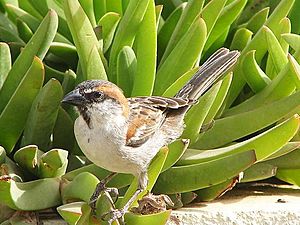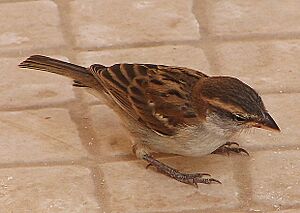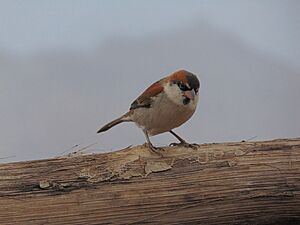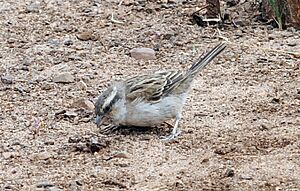Iago sparrow facts for kids
Quick facts for kids Iago sparrow |
|
|---|---|
 |
|
 |
|
| Male (above) and female (below) on Sal | |
| Conservation status | |
| Scientific classification | |
| Synonyms | |
|
The Iago sparrow (Passer iagoensis) is a small bird from the sparrow family. It is also called the Cape Verde sparrow or rufous-backed sparrow. This bird lives only on the Cape Verde islands, which are in the Atlantic Ocean near Africa.
Female and young Iago sparrows are brown with black marks on their backs. Their bellies are a dull grey. You can tell them apart by a clear stripe above their eye, called a supercilium. Male Iago sparrows have brighter bellies and strong black and chestnut stripes on their heads. These sparrows are small, about 12.5 to 13 centimeters (5 inches) long. They make chirping sounds, which are a bit different between males and females.
Scientists once thought the Iago sparrow was closely related to other "rufous sparrows" found in Africa. However, the Iago sparrow looks and acts differently. It also lives thousands of kilometers away. It might actually be more closely related to the house sparrow and Spanish sparrow. The Iago sparrow is common on most Cape Verde islands. It lives in many places like rocky hills and gorges. It usually avoids towns with many people or rich farmlands. Because it is not in danger, the Iago sparrow is listed as "Least Concern" by the IUCN Red List.
Contents
What Does the Iago Sparrow Look Like?
The Iago sparrow is a small bird, about 12.5 to 13 centimeters (5 inches) long. Males and females look different, which is called sexual dimorphism.
Male Iago Sparrows
Male sparrows have a black or dark grey top of the head and a stripe through their eye. The back of their neck is grey, and they have a small white patch on their forehead. The sides of their head, especially above the eye, are a rich cinnamon color. Their shoulders are white and brown. The rest of their upper body is brown with black and light brown streaks. Their cheeks and belly are pale grey. They have a small black patch on their throat and chin.
Female and Young Iago Sparrows
Female Iago sparrows are grey-brown. Their wings and chest have black streaks, and their bellies are pale grey. They look a lot like female house sparrows. However, female Iago sparrows have a clearer pale stripe above their eye. Young sparrows look like adult females. But young males start to show more chestnut colors and a hint of a black patch on their chin early on.
Sparrow Sounds
Iago sparrows make different sounds, including calls and alarm calls. Their usual calls are chirps, similar to other sparrows. Males make a "twangy" cheesp or chew-weep sound. Females make a "more sibilant" chisk sound. Breeding males also sing a long series of these call notes from their nests. When they sense danger, they use an alarm call that sounds like chur-chur-chur.
Where Do Iago Sparrows Live?

The Iago sparrow lives only on the Cape Verde islands. It is common on most islands, but not on Fogo. It is also less common on Santa Luzia, Branco, and Sal.
Iago sparrows live in many different places. These include flat lava plains, rocky coasts, deep valleys, and the edges of farms. They can be found up to 1200 meters (about 3,900 feet) high. They also live in settled areas and gardens. Here, they might live near house sparrows. However, they usually do not live with Spanish sparrows. Spanish sparrows prefer richer farmlands with bigger trees and villages. Iago sparrows stick to drier farmlands with smaller trees. In towns where both house sparrows and Iago sparrows live, house sparrows stay in the busy areas. Iago sparrows prefer areas with trees and open spaces.
Sometimes, Iago sparrows can damage crops by eating young leaves and shoots. Even though their home range is small, the Iago sparrow population is large. Because of this, it is listed as "Least Concern" by the IUCN Red List. This means it is not currently at risk of disappearing.
In 2013, four Iago sparrows were seen in the Netherlands. They had flown onto a ship as it passed by the island of Raso. This was unusual, as they normally only live in Cape Verde.
Iago Sparrow Behavior
Iago sparrows like to be in groups when they look for food and when they breed. When it's not breeding season, they always live in flocks. These flocks can be very large. They sometimes even join groups of other birds, like blackcaps.
Iago sparrows are not very afraid of people. They let humans get close, even when they are at their nests. On the quiet island of Raso, sparrows will even land on human visitors! Since water is scarce where they live, they are very attracted to water sources. Large groups of sparrows will gather when people provide water for them. They often take dust bathing together in small groups. This helps them stay clean when water is hard to find.
What Iago Sparrows Eat
Adult Iago sparrows mainly eat seeds from grass and grain, like maize. They also eat insects and young plant shoots. They can harm crops by eating young leaves. Like house sparrows, they will also eat food scraps found near houses. Baby sparrows, called nestlings, eat mostly insects. These include caterpillars, flies, and orthopterans (like grasshoppers). Iago sparrows usually look for food on the ground. They move around quickly, clinging to the ground like a mouse.
Reproduction and Life Cycle
The Iago sparrow's breeding season usually starts in August and September. This is when the rainy season begins. However, the weather each year can change when they start breeding.
Nesting and Eggs
Nests are often built a few meters apart in small groups of up to 10 pairs. Sometimes, a pair will nest alone. They build their nests in many different places. They usually make a cup-shaped nest in a hole or crack in a cliff or wall. They might also use human-made places like house eaves or streetlights. The nest is made of grass and lined with feathers and hairs. It is packed tightly to be strong.
The female usually lays three to five eggs. Both the male and female sit on the eggs to keep them warm. They also both bring food to their young. However, the female does more of the incubating. They sit on the eggs for short times, about 10 minutes. Males incubate for shorter periods and less often. The male often goes with the female when she finds food for their babies. But he brings less food himself. Once the young birds leave the nest, the male becomes more active in feeding them.



